The onset of summer feels especially big this year, as many of us scale up our social lives after months spent in comfortable, casual clothes. Wondering how to get back in your fashion groove, while still honoring the lessons you've learned? Debra Gunn Downing has some suggestions.
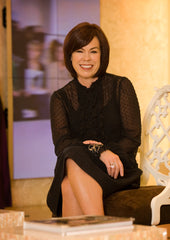 Having started her career in business and advertising, Debra Gunn Downing took an evolutionary route back to her early interest in fashion. She is currently the executive director of marketing for South Coast Plaza, where she’s been for 19 years. Located in Costa Mesa, California, South Coast Plaza is the largest shopping center on the West Coast, and among the top five nationwide.
Having started her career in business and advertising, Debra Gunn Downing took an evolutionary route back to her early interest in fashion. She is currently the executive director of marketing for South Coast Plaza, where she’s been for 19 years. Located in Costa Mesa, California, South Coast Plaza is the largest shopping center on the West Coast, and among the top five nationwide.
Dr. Barb: Today our focus is fashion and all the ways it affects us, how we’re seen, and how we feel about ourselves. Debra Gunn Downing is the executive director of marketing for South Coast Plaza, the largest shopping center on the West Coast. Working with 250 retailers and the communities surrounding their Costa Mesa location has certainly given Deb a perspective on fashion over the past several decades. Welcome, Deb!
Deb: Thank you very much!
Dr. Barb: Eager to speak with you on a topic I have interest in!
Deb: Me too!
Dr. Barb: I understand that you’re a Michigan girl, like me.
Deb: Yes, I was born in Michigan and, gee, I guess I didn’t I didn’t leave Michigan until I was in maybe, my early thirties and have been on the West Coast ever since. But my heart is still there. I love Michigan.
Dr. Barb: What was your path that took you from Michigan to the West Coast?
Deb: You know, I went to school at a private university, Northwood University in Midland, Michigan, as a business major, and worked for a number of years, about eight years, in the oil industry. That’s a real fashion story unto itself; in the early 1980s it was predominantly men. But, you know I got—lack of creativity for me and really a business I wasn’t super-excited about took me to accept a position at an ad agency in Detroit, Michigan, Campbell Ewald, and they moved me to the West Coast to handle their cruise line business, and so I never looked back. I went kicking and screaming, because I loved Michigan and I didn’t want to leave, but I walked into Beverly Hills in February when it was snowing when I left Michigan, and everything was blooming, and I didn’t need a jacket, and it was the middle of February, and I just couldn’t see going back [laughs].
Dr. Barb: Enough said, fully understood, yes. So what’s been your involvement in fashion, how did you find your way more specifically to the fashion industry?
Deb: You know, my university had a fashion merchandising marketing major. In the late 70s, early 80s, no respectable woman wanted to be a fashion major. I wanted respect in the business world, and so I went the business route. But I always had this love for art and fashion and fabrics and that whole realm and eventually I decided, after a sort of midlife crisis, that I was going to pursue that, and I went to work first for Neiman Marcus in marketing and public relations in their store in Beverly Hills and eventually for all of their stores and I moved to Dallas and oversaw that for all stores. And eventually was recruited by a shopping center developer and from there and South Coast Plaza so all those years were really spent in a fashion world in a sense.
Dr. Barb: One of the things I hear from women in my practice and around me with friends is that as we get older we begin to feel a bit more invisible. What’s your perception of what we wear, and how we age, and how we’re seen. How would you speak into that?
Deb: You know, invisible is such a good word, and I think that’s exactly what happens, especially in today’s environment with technology and the internet. Every time I open Instagram there are forty million photos of some twenty year old posing in a fabulous sexy beautiful outfit and she’s perfectly coiffed and perfectly beautiful and of course that can also be photo-shopped, but you’re faced with all of this beauty, young beauty, around you, and how do you find your own place in that and I think what happens is, I think we make ourselves invisible. I see so many women that as they start to age they they fall into the mom jeans and baggy T-shirt thing or they wear the sensible dress with the little low-heeled shoe. They sort of fall into the invisibility factor. I think it’s important for us to break out of that, quite honestly.
Dr. Barb: That’s an interesting perspective, I guess I hadn’t thought about it from that angle, that we are creating it in a way, by our choices.
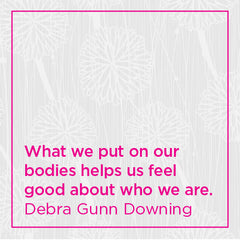 Deb: [laughs] Well, you know, a lot of women as they get older, if you’re in the workplace and you’re dressing up every day, you might be a little bit more inclined to follow fashion. But if you are taking care of the kids and doing the household things, it can be very easy to fall into just a baggy pair of jeans and a t-shirt and what’s comfortable, and I’m a big proponent of comfort, but I think that as we get older it’s so important for our self-esteem our sense of self-worth, to feel good about who we are. And let’s face it, fashion, what we put on our bodies is what does that for us, you know, it’s what gives us our sense of style, defines who we are, says how we feel about the world.
Deb: [laughs] Well, you know, a lot of women as they get older, if you’re in the workplace and you’re dressing up every day, you might be a little bit more inclined to follow fashion. But if you are taking care of the kids and doing the household things, it can be very easy to fall into just a baggy pair of jeans and a t-shirt and what’s comfortable, and I’m a big proponent of comfort, but I think that as we get older it’s so important for our self-esteem our sense of self-worth, to feel good about who we are. And let’s face it, fashion, what we put on our bodies is what does that for us, you know, it’s what gives us our sense of style, defines who we are, says how we feel about the world.
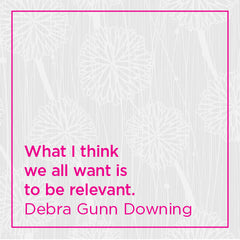 I have a friend who lives, as she says, in jeans. Her husband is an executive with a big company, they travel a lot, and so she has her glam-up outfits for when they are doing dinners or whatever, but during the day, she says, “well I just live in these jeans.” And you know, she had a pair of nondescript ill-fitting jeans on and she had a nice blouse and a nice pair of shoes, but she said, what should I do? And I said, you need to go out right now and buy two of the best, best-fitting designer jeans you can find. If that’s what you're into, you can still be comfortable, but you still need to look good, you still need to feel good about yourself. She said, “you know as I get older and I have a grandchild, I’m starting to feel like, who am I?” I said, get rid of the blazer—she had a big old sweater she would always wear, and I said get rid of the blazer and go out and invest, and I don’t care if it costs $2,000, in a beautiful leather jacket and maybe a pair of sneakers are trendy right now, platform sneakers or you know, a shoe that’s got a trendy heel, and just feel good. And she did. And she called me and said I can’t believe how I feel about myself! I’m not the aging grandmother any more. I’m someone relevant. And that’s what I think we all want, is to be relevant.
I have a friend who lives, as she says, in jeans. Her husband is an executive with a big company, they travel a lot, and so she has her glam-up outfits for when they are doing dinners or whatever, but during the day, she says, “well I just live in these jeans.” And you know, she had a pair of nondescript ill-fitting jeans on and she had a nice blouse and a nice pair of shoes, but she said, what should I do? And I said, you need to go out right now and buy two of the best, best-fitting designer jeans you can find. If that’s what you're into, you can still be comfortable, but you still need to look good, you still need to feel good about yourself. She said, “you know as I get older and I have a grandchild, I’m starting to feel like, who am I?” I said, get rid of the blazer—she had a big old sweater she would always wear, and I said get rid of the blazer and go out and invest, and I don’t care if it costs $2,000, in a beautiful leather jacket and maybe a pair of sneakers are trendy right now, platform sneakers or you know, a shoe that’s got a trendy heel, and just feel good. And she did. And she called me and said I can’t believe how I feel about myself! I’m not the aging grandmother any more. I’m someone relevant. And that’s what I think we all want, is to be relevant.
Dr. Barb: That’s an interesting comment because part of what I do within women’s health is sexual health, and certainly self-image and self-esteem is pretty critical to women enjoying sexual health, and although that particular aspect may not always involve clothing, I think, part of it certainly does. As we’re in loving relationships or establishing ourselves in relationships, so what advice do you have for women about finding that piece, that look, and I think you just spoke into it a little bit about discovering what you’re comfortable in, but more broadly, can you help listeners understand kind of how to find that spot where they can feel really good about themselves and comfortable.
Deb: One of the things I recommend for someone who’s not involved in fashion or who doesn’t feel like that’s their thing, and in that case women tend to become creatures of habit, they wear the same thing. One of my sisters has 25 of basically the same sort of tunic blouse in her closet and I was shopping with her recently and she said, “what do you think of this?” I said, “no! You’ve got a whole closet of them. How about this?” And I held up—she wears a lot of blazers—and I held up a blazer with a flower print all over it and she said, “I never saw myself like that.” Sometimes it takes someone else to move you past those boundaries, you know. A stylist, a sister, a friend.
I do it with my 27-year-old daughter. She’s brutally honest, both on the good and the bad. I can remember shopping with her when she was in junior high and I would come out of the fitting room and ask, what do you think? And she would say, “Mom, it looks like a mom trying to be a teenager.” So I think having the honesty of someone who can not only tell you what you shouldn’t be doing but encourage you to move into an area that you’re not 100-percent comfortable with, but that is good for you, that looks good on you. We all have a closet full of things that should probably be cleaned out. Closet cleansing is super-important. Get rid of those things. Make way for the new. It will feel so good and so cleansing but you’ll feel better about yourself.
I think in the sexual health arena too, I think that at a certain age, we should not be showing cleavage; it’s not attractive any more. You can certainly, under your clothing wear some sexy lingerie and still feel sexy and good about yourself, but not look inappropriate.
Dr. Barb: That makes perfect sense. Talking about the closet, do you recommend that you do that we do that with someone like a sister or a daughter, do you think we can be our own best critic and honestly make assessments? Or does it really take another person to help us engage in that?
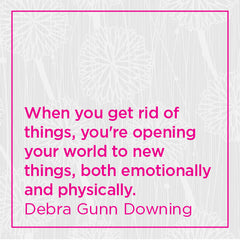 Deb: I don’t think we can help ourselves easily, because there are too many factors in the way. I think you need a friend, a sister, all the stylists do this as a matter of course in their business: They’ll come over and cleanse the closet that way they can also see what your wardrobe is so that they can build on it. I think what happens is we all buy things that were too expensive or didn’t fit just right or we didn’t get the cost per wear, we didn’t get the CPW out of it, so it’s hanging there and we think, oh it’s horrible, I shouldn’t throw that away, I shouldn’t get rid of that, so we do need someone to come in and I do it with a friend of mine constantly and she holds it up and I’ll say no, it’s gotta go and she’ll try to fight for it sometimes, but [laughs] but you know when you get rid of things, you’re opening your world up to new things, both emotionally and physically, so I think it’s important.
Deb: I don’t think we can help ourselves easily, because there are too many factors in the way. I think you need a friend, a sister, all the stylists do this as a matter of course in their business: They’ll come over and cleanse the closet that way they can also see what your wardrobe is so that they can build on it. I think what happens is we all buy things that were too expensive or didn’t fit just right or we didn’t get the cost per wear, we didn’t get the CPW out of it, so it’s hanging there and we think, oh it’s horrible, I shouldn’t throw that away, I shouldn’t get rid of that, so we do need someone to come in and I do it with a friend of mine constantly and she holds it up and I’ll say no, it’s gotta go and she’ll try to fight for it sometimes, but [laughs] but you know when you get rid of things, you’re opening your world up to new things, both emotionally and physically, so I think it’s important.
Dr. Barb: So back to some of the rules of women doing appropriate fashion application and aging gracefully, you mentioned one about cleavage. Can you review in your mind, maybe some basic rules or maybe some fashion absolutes that we should all, we could all maybe generally embrace?
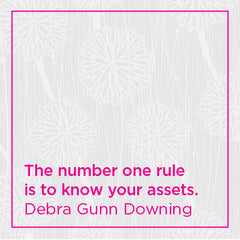 Deb: I think the number one rule is to know your assets. At any age, but as you’re aging, there’s that old adage that, the legs are the last to go and many women have beautiful legs, so don’t be afraid to show them. But if you feel your arms are crepey and wrinkly and you don’t want to show them, don’t show them! Wear long sleeve or a three-quarter sleeve. You’ll feel better about yourself you don’t feel like you have to hide something. But then some of the other rules that I think the mistake some women make, especially the cleavage thing, because you know, once you’re past 30, that probably doesn’t look that good anymore. You need to be able to look in the mirror and say, “does this look good?” But I think cleavage is one, and I think too much makeup often happens, too, because we’re starting to, we worry about aging, trying to compensate, but really less makeup is more youthful.
Deb: I think the number one rule is to know your assets. At any age, but as you’re aging, there’s that old adage that, the legs are the last to go and many women have beautiful legs, so don’t be afraid to show them. But if you feel your arms are crepey and wrinkly and you don’t want to show them, don’t show them! Wear long sleeve or a three-quarter sleeve. You’ll feel better about yourself you don’t feel like you have to hide something. But then some of the other rules that I think the mistake some women make, especially the cleavage thing, because you know, once you’re past 30, that probably doesn’t look that good anymore. You need to be able to look in the mirror and say, “does this look good?” But I think cleavage is one, and I think too much makeup often happens, too, because we’re starting to, we worry about aging, trying to compensate, but really less makeup is more youthful.
And then the other thing I think is one of the rules is: hairstyle. There aren’t really rules in terms of, hey you get to a certain age and you have to cut your hair off, because people of all ages look good in different hair lengths, I happen to be more suited to short hair, but I have a friend who’s 70 and she has long hair past her shoulders and she looks beautiful. So I think knowing your look but, change your hair up cut it off sometimes, get some bangs, have some highlights put in and I think especially as we get older, the changing it up makes us feel relevant, feel less invisible.
Dr. Barb: When it comes to fashion musts, is there a short list of what we all likely should have in our closet?
Deb: I’m a big believer in timeless basics that you build on. Everyone needs a pant that’s not a jean that can be—today there are a lot of options it could be a wide leg, it could be a straight leg, but a very good quality pant and maybe it’s black or navy in a classic cut, and then definitely a good jean, and I think the older we get, the further we need to get from ZARA. We need to be, we need to find a really good cut that works well for us, and that fits our body appropriately so we can feel good about ourselves.
And then I also think it comes down to building a wardrobe based on personal style and lifestyle. For me, I have three rules, and a little bit of a fourth for when I buy anything, and quality and fit are the top two. Buy the best quality you can afford. If you can only buy one jacket this season, then make it the best quality, tailor it to fit exquisitely. And my third for me must is an edge. I like a little bit of a fashion edge to it, I’m not good in a preppy look or a conservative look, I need a little bit of an edge. And then the fourth for me is comfort. And I think that’s pretty true for many of us. Nobody wants to be uncomfortable I don’t want to be tugging at something all day. Everything for me is an overlay of what is timeless. That doesn’t mean it’s not edgy or trendy, but it needs to run the gamut of multiple seasons, I mean, just for me, just in terms of how I live my life, I like to keep my clothes for a while. I don’t want disposable clothing. I don’t want to waste things. I occasionally do buy fast fashion to fill in a piece here and there, but I’d rather buy quality and have it for a long time. So that to me, if you find a framework of quality, fit, and then whatever is the sort of style icons are for you, the edginess or the preppiness or whatever, and you bracket your purchases within that area, you can’t go wrong. You’re going to build, and to think about it as building over time, if you build on quality you can keep those pieces for a long time and you can just continue to add the trendy jacket or the interesting shoe or that sort of thing.
One of my other big rules is shoes, because I think we tend to forget about shoes or we tend to think we’re going to buy one pair of shoes and it’s going to go with everything. That’s not the case. A shoe has a very important element in the finished look, in having yourself look put together. So I would say pay attention to the shoes.
And buy what gives you confidence, buy what makes you feel good.
Dr. Barb: And what resources are available for a stylist for those who don’t live in a big urban area or don’t have the confidence or comfort of inviting a stylist into their life. Are there books or online resources that can help an individual move through this?
Deb: Well, online is always a resource. I was traveling for instance, last year to Japan, and wanted to pack minimally and be able to fit in, so I went online to see what is the current style in Japan, and they were wearing wide leg trousers and crop jackets, so I think researching online for what the current looks are and then analyzing yourself and what’s going to work for you you know, I’m short. I can’t take a lot of fabric, so something that’s super voluminous, even if it looks chic as can be, isn’t going to be right for me, so I think doing that research, and then, when you do go shopping, and many times if you don’t have those local resources, it would make sense to go to the city and go to a department store. Because, you’re going to have a lot of options and all the big department stores like Saks and Nordstroms and Neiman Marcus, their sales associates are trained as stylists in a sense, but they also have stylists on staff that do not cost you anything, you’re not paying for the stylist’s time, so make an appointment in advance with the stylist at Nordstrom, give her, Skype with her or show her your look, tell her about your lifestyle and have her pull for you. And that will go a long way toward helping move you into the next realm of style.
Dr. Barb: And what about,on the subject of shopping, not every woman enjoys it but yet, has a desire to be fashionable. Do you have good resources for women who don’t want to walk into a shopping center or store to do their shopping. Besides Nordstrom online their store, are there any good age-appropriate combination of clothing or fashions that women could access?
Deb: Are you saying online or just in general?
Dr. Barb: Online.
Deb: You know, online is tough, especially for someone who isn’t as comfortable with fashion or style because there’s a rule of thumb, the industry average 33 percent return rate, and with someone who’s doing a lot of trial and error it’s probably 75 percent, so if you don’t mind getting the stuff in at home and having a friend or someone come over and help you and then sending back what you don’t buy, that’s certainly an option. There are also some online resources where you sort of fill out a form about what your lifestyle is, what you like, they ask you a lot of questions, show you a lot of photos and then they send you, for a monthly fee they send you three outfits, I think it is you can probably create whatever you want out of it and then you, the more of those things you keep, the lower your price is. So doing some of that online could help because they’re also providing an online stylist in a sense. I think that a lot of the online sites, particularly the big Matches and Farfetch and the big fashion sites are starting to do a lot more personalized service and interacting with the customer for someone who’s not that comfortable, who doesn’t want to go to a store, that could be a good option.
Dr. Barb: What would you say is the best thing about being our age? I’m going to put my age close to your age, I think. What is the best thing about being our age, as far as fashion is concerned?
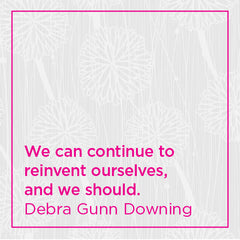 Deb: You know what I really love about it is that you’re freer. You know, you can take risks more. You don’t have to be so concerned about our looks. It’s not that we’re not necessarily concerned, but there’s a mental freeness about it, because you get to a certain age and you aren’t as hung up, you’re a little more comfortable with yourself, you’re a little more at ease. That, I think, is a real benefit. I have a friend in Beverly Hills, she’s well into her 70s. She’s always been a fabulous dresser and I don’t know how long abo, but maybe seven or eight years ago she started dressing almost outrageously. If you walked into a room and you saw her she’d be in the most fashion forward, fashionable, trend-setting thing you’ve ever seen and some sort of a head piece and an enormous skirt with hoops under it but, completely stunning. In fact, she’s always in all the photos when she goes to an event she’s in all of the photos and not as a ‘Glamour Don’t’ but as a ‘Fabulous Do.’ So I think she has the confidence to carry it off and I think that’s where we need to continually work on our confidence and self-esteem as we grow older, because we can be anything we want, we can continue to reinvent ourselves, and we should. Staying young and feeling relevant and feeling modern makes you feel good, makes you feel sexy.
Deb: You know what I really love about it is that you’re freer. You know, you can take risks more. You don’t have to be so concerned about our looks. It’s not that we’re not necessarily concerned, but there’s a mental freeness about it, because you get to a certain age and you aren’t as hung up, you’re a little more comfortable with yourself, you’re a little more at ease. That, I think, is a real benefit. I have a friend in Beverly Hills, she’s well into her 70s. She’s always been a fabulous dresser and I don’t know how long abo, but maybe seven or eight years ago she started dressing almost outrageously. If you walked into a room and you saw her she’d be in the most fashion forward, fashionable, trend-setting thing you’ve ever seen and some sort of a head piece and an enormous skirt with hoops under it but, completely stunning. In fact, she’s always in all the photos when she goes to an event she’s in all of the photos and not as a ‘Glamour Don’t’ but as a ‘Fabulous Do.’ So I think she has the confidence to carry it off and I think that’s where we need to continually work on our confidence and self-esteem as we grow older, because we can be anything we want, we can continue to reinvent ourselves, and we should. Staying young and feeling relevant and feeling modern makes you feel good, makes you feel sexy.
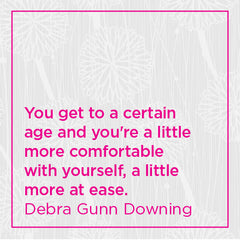 Dr. Barb: Yes, it absolutely does, I think the right outfit makes all the difference on certain days and certain events and certain circumstances. And I think when we wear something that makes us feel good and confident, others will notice and likely comment, which helps me understand and establish what is a “Glamour do,” as you say, versus a “Glamour don’t.” encourage women as friends and colleagues to speak into that and offer up that compliment and comment of encouragement and enthusiasm around some of the maybe more daring things we might see our friends do.
Dr. Barb: Yes, it absolutely does, I think the right outfit makes all the difference on certain days and certain events and certain circumstances. And I think when we wear something that makes us feel good and confident, others will notice and likely comment, which helps me understand and establish what is a “Glamour do,” as you say, versus a “Glamour don’t.” encourage women as friends and colleagues to speak into that and offer up that compliment and comment of encouragement and enthusiasm around some of the maybe more daring things we might see our friends do.
Deb: I could not agree more because I think that does give us confidence, especially someone who’s trying to step out a little, to move out of that invisibility factor. We want to build them up and as women, we should help one another in that way. There’s no better fashion accessory than confidence. It just makes everything feel good.
Dr. Barb: Yeah, nicely said. Do you have hope and confidence that the fashion industry is going to continue to think about the mature woman, the over 50 woman as they continue to create fashion, do you think that we are less invisible to them as they are forward-thinking about what would make us feel sexy and confident?
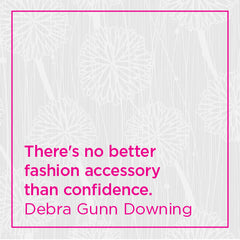 Deb: You know, I do. It’s a good time for women right now. It’s a good time for aging women in the fashion industry. I don’t know if you’re familiar with this, but in the past couple of years, the number of older models who have walked the runway and I mean older, from fifty to seventy is pretty startling with the designer shows.So the designers understand she’s the customer they need to embrace, she’s the one with the money, she’s the one that’s buying it. But it’s also a business, so you’ve got this up and coming client that you need to address and I think, good for the designers that they continually—Karl Lagerfeld, in his eighties, is still trying to create relevant and interesting fashion and It is maybe looking on the runway like it’s only geared for an audience, but if you walked into that store and start to look at the individual pieces, whether it’s Chanel or Max Mara or J Crew, you start to see the pieces are what we buy. We’re not all head to toe any designer or any brand generally, but there is something there for everyone. I don’t really see an ageism in fashion that is intentional, but I think again because it is a business and they need to keep the business going and because these are creative people and they are continually pushing the boundaries and sometimes the boundaries work for us and sometimes they don’t. But, there’s always, I believe there’s always something for everyone in there. And I’m not a believer, in one of the magazines used to have this section in the magazine that, what you wear in your 20s, 30s, 40s, 50s, and every month I would look at that and I td think, well I like some pieces from the 20s and I like some from the 60s and the 40s and I would wear any of them. I don’t like the hard and fast rules and I don’t think any of us should take that at face value in that way.
Deb: You know, I do. It’s a good time for women right now. It’s a good time for aging women in the fashion industry. I don’t know if you’re familiar with this, but in the past couple of years, the number of older models who have walked the runway and I mean older, from fifty to seventy is pretty startling with the designer shows.So the designers understand she’s the customer they need to embrace, she’s the one with the money, she’s the one that’s buying it. But it’s also a business, so you’ve got this up and coming client that you need to address and I think, good for the designers that they continually—Karl Lagerfeld, in his eighties, is still trying to create relevant and interesting fashion and It is maybe looking on the runway like it’s only geared for an audience, but if you walked into that store and start to look at the individual pieces, whether it’s Chanel or Max Mara or J Crew, you start to see the pieces are what we buy. We’re not all head to toe any designer or any brand generally, but there is something there for everyone. I don’t really see an ageism in fashion that is intentional, but I think again because it is a business and they need to keep the business going and because these are creative people and they are continually pushing the boundaries and sometimes the boundaries work for us and sometimes they don’t. But, there’s always, I believe there’s always something for everyone in there. And I’m not a believer, in one of the magazines used to have this section in the magazine that, what you wear in your 20s, 30s, 40s, 50s, and every month I would look at that and I td think, well I like some pieces from the 20s and I like some from the 60s and the 40s and I would wear any of them. I don’t like the hard and fast rules and I don’t think any of us should take that at face value in that way.
Dr. Barb: Yes, I like, because I would agree with that. I have three young adult daughters too and I occasionally thing, well wait a minute, is this the look that I should be doing or am I transferring one of the looks my daughters should be doing, you know, that line of age-appropriate. I like your take on, you know, if you wear it with confidence, it doesn’t belong in any decade of your life specifically.
Deb: No! And if you keep always with a filter to, what is appropriate for me? My daughter is tiny and she might wear a tiny little short shorts. I’m not going to do that, but maybe there’s a piece of that look, maybe it’s the denim skirt, or I might wear a denim dress that is still a piece of that look and it’s age appropriate for me. And the flip side also works, I must say, my daughter raids my closet like crazy, so something must be happening in my closet that is relevant, because she lives in Los Angeles and I live south in Orange County and I’ll come home and I’ve got things missing and I call her, do you have XYZ? “Oh, yeah, Mom, I borrowed that, I hope you don’t mind.” So I think you’re right, we can’t stay in those lanes, that this is only for the twenty-somethings and this is only for the sixty-somethings, we need to mix it up.
Dr. Barb: Yes, that great, that’s refreshing news to me. So as we conclude our time together today, Deb, I often like to end our time by asking, where do you find fullness at this stage of your life. Can you share with the listeners?
Deb: Yeah, for me it’s about finding what feeds my soul, and for me it’s art and nature. I’m into mindfulness. I’m trying to be, especially as I age, try to be more present in the present moment there’s a story that I just love about my partner of 10 years, his mother just passed away, and she was the most incredible at 96, she was an artist, she was a fabulous woman. She told me a story one time about she’d had a small business venture with a friend, and this we 30 years ago they owned a duplex or something together and the two women sold it and they each, their proceeds each was $10,000, which might be $20,000 or $30,000 today, but anyway, she took the entire proceeds, and she bought a painting, because art fed her soul, and I think that’s the way I want to live my life. I want to know what feeds me personally and I want to gravitate toward that. We all have our work and our things that we have to do in life, but I know I need to spend so much time in nature every day looking at something green or wandering in a museum and just feeling the stimulation of art those things, I think are more important the older we get, because that’s how we age fabulously.
Dr. Barb: Those are great words, and I hope that now that spring and summer are coming you can make your way back to Michigan so you can enjoy the beautiful nature we have to offer here.
Deb: Oh, Michigan is so beautiful.
Dr. Barb: Thank you so much for your time today Deb and thanks for sharing.
Deb: Well, Barb, it was my pleasure and I’ll look forward to meeting you in person one of these days when I’m in Michigan.
Dr. Barb: Okay.
 Dr. Barb DePree, M.D., has been a gynecologist and women’s health provider for almost 30 years and a menopause care specialist for the past ten.
Dr. Barb DePree, M.D., has been a gynecologist and women’s health provider for almost 30 years and a menopause care specialist for the past ten.


0 comments